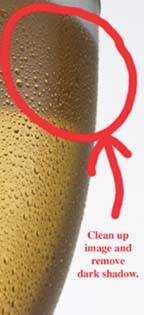One of the nice benefits of digital camera images is that there is no dust or dirt to clean up on the images! Scanned images always pick up some form of dirt or dust on the way in, which would have to be cleaned up in retouching. (Hey, at least it gave us something to do!) Quality scanning of transparencies or prints usually involves the use of a drum scanner. Flatbed scanners can be used for scanning transparencies, but the quality is not as good as with a drum scanner. Some clients realize this and will insist on drum scans.
High-end drum scanners cost thousands of dollars and require regular maintenance and servicing; it's like owning a Ferrari! Of course, the cost of the scanners is reflected in the cost of the scans; clients no longer want to pay the high prices for these quality scans, and as such, they have either demanded digital shots or insisted on lower prices from the high-end shops supplying the scans. Images coming from a digital camera don't suffer from these artifacts.
Make Sure You Understand Your Instructions
Once we have the images to be retouched in one form or another, it is the job of the retoucher to interpret retouching instructions supplied by the client. The retouching instructions can come in two forms, either from the internal coordinator who has been in direct contact with the client or sales representative and has a marked up first proof, or by having the client come into the shop or studio to sit down with the retoucher and relay the verbal instructions into onscreen changes. Yes, you have to be comfortable working with someone breathing down your neck as you retouch sometimes. I have found that if you take control of the situation and show that you are confident with your retouching, you won't have a problem.
Don't Be Afraid to Offer Suggestions
I should point out up front that, in my experience, when an art director or client is with you and they are trying to achieve a desired result, they really do appreciate your input and suggestions! A photo retoucher that just goes through the motions without showing any creative flair, offering little advice or suggestion, is a person I would classify as a mechanical retoucher. Trust me, you do not want to be a mechanical retoucher. You should make yourself open to suggestions, and be able to understand and relate information into tangible results with a creative flair.
Review the Initial Proof
Clients typically arrive with (or send in) proofs of the images to be retouched. These proofs have been supplied to them from an initial scan done by a film house, or they have generated the proofs themselves. The client will go through the proof and mark up the changes and corrections he wants you to make. These marks can vary widely. I have seen an instance when a client has circled every single piece of dirt (as opposed to just giving a general indication of an area to be cleaned up). Others make simple, general requests like the one in Figure 1-6. I've also been in situations when bubbles on a frosty glass needed to be changed and moved around. And I've even had instructions that are vague at best, like the image is "too sweet." In many cases, a lot can be left up to the imagination, and it will be your job to figure it out. Some clients are coherent, clear, and concise; others seem quite reserved, artsy, or just may not really know exactly what they want. Hopefully, after reading this tutorial, you can help your client find what she is looking for and run with it.
Figure 1-6. Image marked up with instructions for retouching
